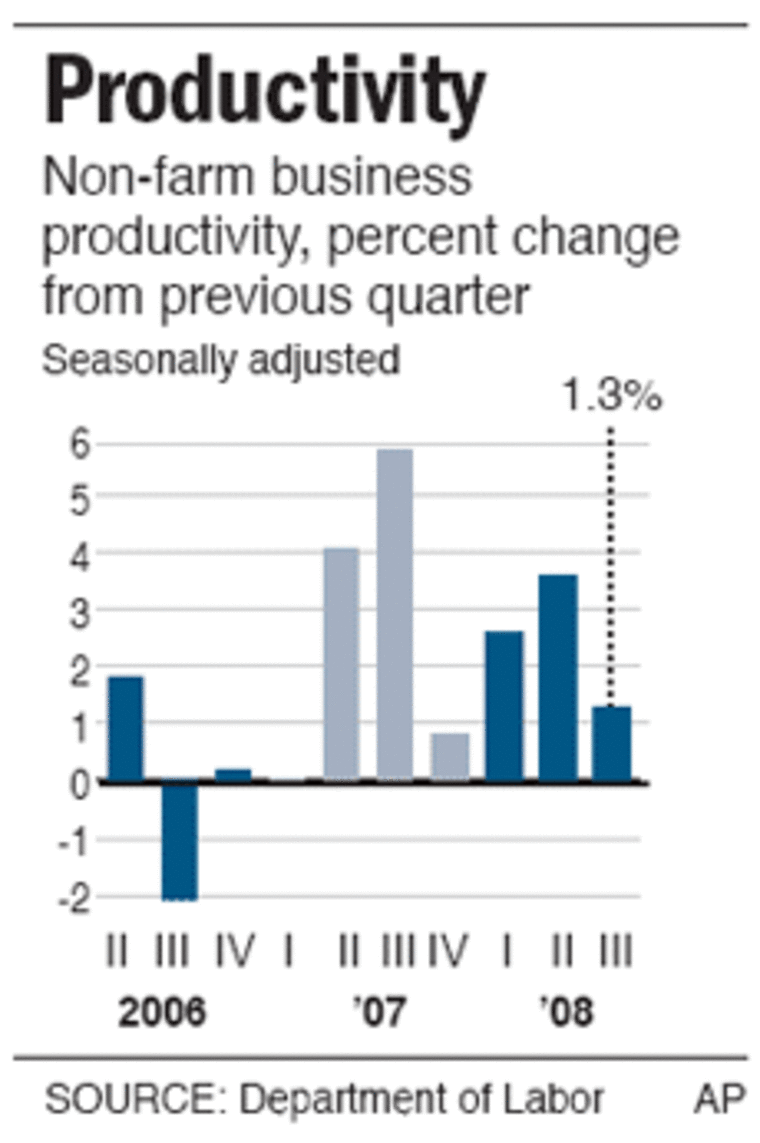U.S. worker productivity slowed in the summer while wage pressures increased, but both developments were better than expected and are unlikely to raise inflation alarms at the Federal Reserve.
Meanwhile, the U.S. service sector, which includes hotels, retailers and other industries, shrank more than expected in November. The Institute for Supply Management, a trade group of purchasing executives, said Wednesday that readings for new orders, employment and prices all hit the lowest levels on records dating back to 1997.
The Labor Department reported Wednesday that productivity, the key ingredient for rising living standards, rose at an annual rate of 1.3 percent in the July-September quarter. That's down from the 3.6 percent growth rate in the second quarter, but slightly higher than the 1.1 percent increase initially reported a month ago and better than the 0.9 percent rise economists expected.
Wage pressures, as measured by unit labor costs, rose at an annual rate of 2.8 percent, after having declined at a 2.6 percent rate in the second quarter. The rate of increase in the third quarter was the biggest jump since a 4.5 percent rate in the fourth quarter of last year, but was below the 3.6 percent advance originally reported and that economists expected.
The Fed closely monitors developments in productivity and wages to see if inflation is getting out of hand. But the central bank was likely to view the recent developments as temporary and not long-run trends.
The ISM said its services sector index fell to 37.3 in November from 44.4 in October. It was far below the reading of 42 expected by Wall Street economists surveyed by Thomson Reuters. A reading below 50 signals contraction, while a reading above 50 indicates growth.

Of 18 industries in the survey, including warehousing, real estate, restaurants and wholesale trade, only one — health care and social assistance — reported growth. The report, based on a survey of the institute's members, covers indicators including deliveries, inventories and backlogs.
Analysts had expected a big downward revision in productivity given the fact that overall output, as measured by the gross domestic product, was revised to show a decline of 0.5 percent at an annual rate, a bigger drop than the 0.3 percent decrease that was originally reported.
Weakest since 2007
Still, the 1.3 percent rise in productivity was the weakest showing since a 0.8 percent rise in the fourth quarter of 2007.
While rising wages and benefits are good for workers, if those gains outstrip increases in productivity it can create serious inflation problems as businesses are forced to boost the cost of their products to cover the higher wage demands.
If workers are more productive, though, businesses are able to increase their pay and cover the costs with the increased output of goods and services.
The Fed was likely to view the latest development in productivity and labor costs against the backdrop of an economy that has fallen into a recession. During a recession, output falls, which hurts productivity, but rising job layoffs keep a lid on wage pressures.
Inflation concerns practically disappeared last month after a report showed that consumer prices in October took their biggest monthly plunge in the six decades that records have been kept.
The big fall in prices in October primarily reflected the fact that energy prices, which had been surging earlier in the year, are now declining sharply.
The Fed, trying to get the country out of the recession, cut interest rates by a full percentage point in October. The federal funds rate, the interest rate that banks charge each other, fell to 1 percent, a level seen only once before in the past half-century.
Economists believe the Fed will cut rates again at their next meeting on Dec. 15-16.
A panel of economists with the National Bureau of Economic Research announced Monday that the country has been in a recession since December 2007, making the current downturn the longest in a quarter century. The 1981-82 recession last 16 months.